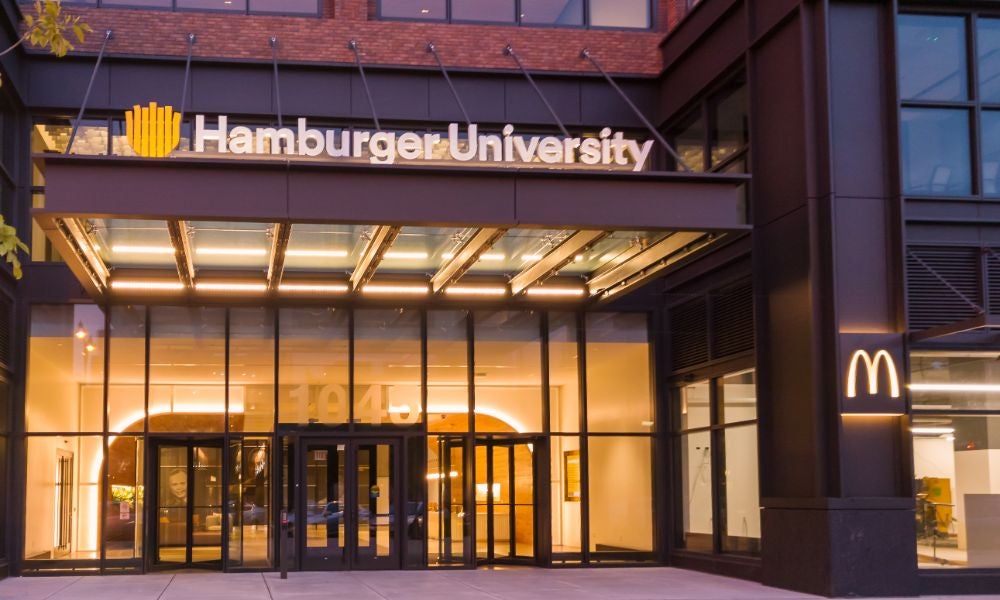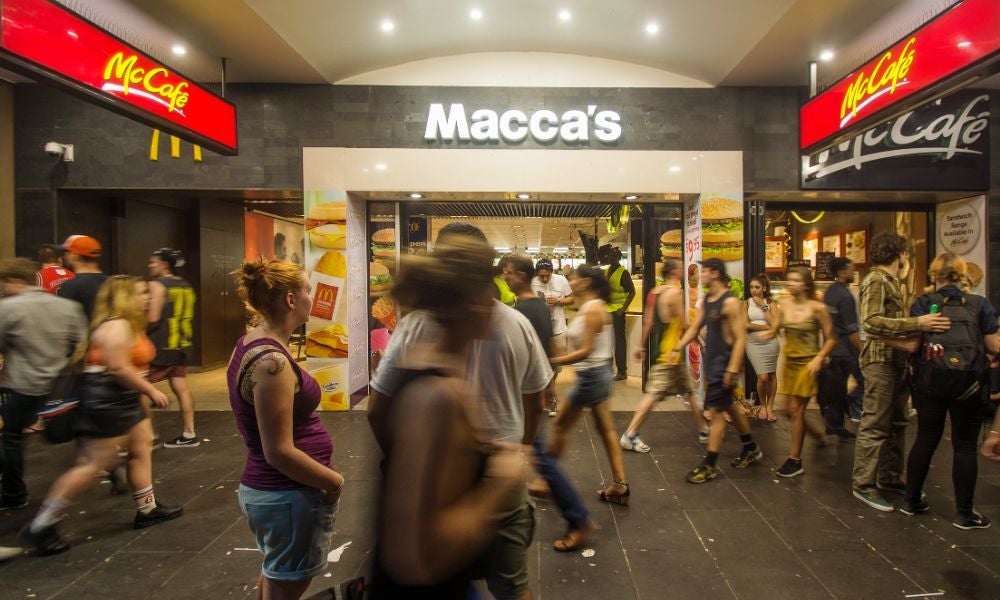The McDonald’s Australia story: the power of home-grown leadership
McDonald’s Australia founding father Peter Ritchie says businesses must refocus on training leadership to obtain global relevance
Peter Ritchie AO brought McDonald’s to Australia, but he sees his true legacy as the laser focus on training that helped the growing local presence become a global leader in efficiency and quality. To him, it’s obvious: investing in people leads to better outcomes.
However, it’s this appreciation for the importance of good training that Mr Ritchie says is missing in the Australian business landscape – and what’s keeping local enterprises from enjoying the global reach of multinationals like McDonald’s. For Australia to become a global player in business, he argues, it must reprioritise training home-grown leaders.
During a recent talk with AGSM Director Professor Nick Wailes – the latest in the AGSM Director’s Lunch series of dialogues with leaders from the corporate, government and for-purpose sectors – Mr Ritchie recounted his career, beginning with earning a Bachelor of Commerce degree in accounting at UNSW Business School, through three decades as CEO/Chairman of McDonald’s Australia to the ventures he supports today. At every step, he found himself focusing and relying more on training.
“I’ve got a real bee in my bonnet about training in general in Australian industry and about leadership in Australia,” he told an audience of AGSM students and alumni. “I think most of us here are yearning for stronger, better leadership.”
Mr Ritchie, who also talked about his recent book, The Magic of McDonald’s: Bring it to Your Business, explained that good training hinges on detail, structure and tracking. Done right, it provides the self-confidence needed to lead, creating great entrepreneurs.

From accounting to McDonald’s Australia
According to Mr Ritchie, much of his journey has resulted from being open to taking chances, and he never approached leadership in a structured way, simply acting by instinct at first. At UNSW, he said, he opted for an accounting degree because he saw that it would be valuable in any business career, but academics had never been his main focus. “I was a sportsman masquerading as a businessman, really. I was in every sporting team that I could get into at the university, and I took a bit longer to get my undergraduate degree as a result,” he said.
After gaining some experience working for a Chartered Accountants firm and managing a property development company, Mr Ritchie accepted an offer to train with McDonald’s in the US with the aim of bringing its fast-food stores to Australia. He had no grand career plan – in fact, it was mere curiosity about the IQ test involved in the interview process that first sparked his interest in the role.
“I joined McDonald’s more or less as an adventure,” he said, noting that the company’s commitment to building local management attracted him. He and his wife completed the McDonald’s Hamburger University training program in Chicago. Then they returned to Sydney, where Mr Ritchie was immediately in competition with counterparts in Germany and Japan in a race to open the first McDonald’s outside North America.
Read more: What is the #1 missing link in business strategy implementation?
Mr Ritchie came in second in that race, after Japan, when the first Australian McDonald’s opened its doors in Yagoona in December 1971. “It was a real battle right from the start,” he said. “We did half what we’d projected in sales, people hadn’t heard of McDonald’s at all, and we couldn’t find any dollars for advertising.”
McDonald’s Australia lost $15 million over its first eight years, supported by the parent McDonald’s Corporation and bank loans, but in the early 1980s it began to turn a profit. Mr Ritchie said he could have just “rolled on from there” but that, “at that time, I wasn’t satisfied with our standards” – it was clear they were running a mediocre operation compared with their peers, both in fast food and in the McDonald’s global family.
‘Lift and lift and lift’
Looking to root out the problem, Mr Ritchie and his leadership team took a trip to “find the best that we can measure ourselves against, and then work out how we lift our standards to that point”. Impressed by the quality of McDonald’s stores in Singapore, they realised the issue was that Australia’s labour costs were too high – their stores couldn’t afford even half the staff as Singapore’s. But he couldn’t accept that the problem was unsolvable.
“If we can’t afford that number of people, we’ve got to make the people that we can afford that much more efficient,” he said. “And the answer, of course, is making them more effective, more capable.”
When Mr Ritchie approached the US executives with his plan for 1986, he was almost surprised when they supported it. He planned to spend 35 per cent of his corporate bottom line on additional training. “What did that mean? Well, I built a facility, hired more training people, upgraded the facilities we had, and generally just spent money on anything that I thought might make our people able to learn better and be more creative,” he said.

He also updated the company’s training manuals, rewriting them with greater detail. McDonald’s Corporation ultimately adopted them for use across its global organisation, where it remains the standard today.
Mr Ritchie said his team wanted to develop an even more fundamental focus on training at McDonald’s Australia than their “really good role models” in the US had. “Their training facility was very proud of the job they’d been doing, and they had done a good job. But I said, ‘Okay, we’re going to do a better job. Everything that we do is going to be better than Hamburger University.’”
As a result of this refocus, Mr Ritchie recalled, the quality of his stores began to improve slowly. “By the end of the year, I was getting letters from customers saying, ‘I don’t know what it is you’ve done in your stores, but our experience has been so much better in recent times,’” he said. “Think about what it must have taken for somebody to write a letter about their recent hamburger experience to the managing director.”
Encouraged by the results, Mr Ritchie continued his considerable training spend for five straight years. And it worked: by 1991, Australia had gone from near the bottom of measurements of McDonald’s stores’ capability and efficiency to the top spot it still holds today. “What I did, of course, was just lift and lift and lift the capability of our training people and the job they did in the stores,” he said. “That’s why I’ve got this ongoing focus on training.”
Read more: Reimagining marketing: making business strategy meaningful
Lessons on training and leadership
The lessons Mr Ritchie learned throughout his career about the importance of training have shaped his views on leadership, and he opined that it’s an Australian quality to build a career in business in this intuitive way rather than with purpose. As with the sportsman’s approach to business he adopted out of necessity, he said, there’s a better way to build leaders from the ground up.
“Leadership came more or less with my awareness about training, because I saw leaders jumping out of the woodwork in the people I’d trained,” Mr Ritchie said. Young people would be eager for more experience and responsibility, and by nurturing that ambition with opportunity, he could identify leaders and support their career prospects internally. Ultimately, he said, this is how “McDonald’s Australia became a goldmine for the McDonald’s world” of leadership.
Later, as a Business Council of Australia member, Mr Ritchie had an epiphany about Australia’s business community when working on a talk IBM’s managing director had asked him to give to his senior management group. In canvassing other Australian business leaders about leadership, he said, it was clear that they all relied on instinct; none had explicitly thought about the leadership process.
“I realised that it was so easy to learn, and I think Australia makes a big mistake,” Mr Ritchie said. “We don’t teach the basics of leadership. There are leadership classes, but they start too far up the chain; they don’t start with the basics of working as part of a team as young people do at McDonald’s.

"That’s where it started for me, and I’ve been trying to help people to develop leaders where they’re in their own organisations for a long time. But I’m despairing a little bit because I’m not seeing a lot of really capable, self-confident young leaders emerging,” he continued. “I thought about that question: why are we all yearning for better leadership? And I think it stems back to the way we’ve been trained.”
Training leaders in a changing business world
According to Mr Ritchie, who recently advised the founders of Guzman y Gomez on their initial public offering, the rapidly changing nature of business and the consumer experience today makes a focus on high-quality training more important than ever.
He has found that the keys to training are detail, structure and follow-up – and they are relevant across careers and organisations, regardless of status or size. “Even if you’ve only got one person working for you, you have to train them with the sort of approach McDonald’s takes. And that is detail,” he said, noting that, for McDonalds, this level of detail extended down to teaching employees how to greet customers: “Don’t take anything for granted: break things down into step-by-step processes and teach them step-by-step, with real patience.”
Subscribe to BusinessThink for the latest research, analysis and insights from UNSW Business School
The structure of training is equally vital, as structured training empowers people with career purpose, direction and drive. “You have to show people where they go next, where that detailed training is going to lead,” Mr Ritchie explained. “Where do you go on to once you’ve learned to cook French fries? What’s your next step? And what are your third and fourth steps? That’s the structure you’ve got to set up.”
Finally, follow-up involves tracking and reviewing people’s capabilities on particular tasks to ensure the training leads to desired outcomes. As Mr Ritchie noted, he was comfortable moving people within the organisation because he knew that if they proved themselves capable in one area, they’d generally be capable in another.
Most importantly, training gives employees the tools they need to succeed in business and to become effective leaders. “What we’ve found is that when they’ve gone through that training, they become much more self-confident, and they are able to do it more naturally and intuitively,” Mr Ritchie said. “I think you have to leave it to people’s initiative and imagination, and that comes from self-confidence and exposure to circumstances. That’s what I’ve seen as I’ve grown young leaders in McDonald’s.”
This is where Australian businesses can do better, Mr Ritchie concluded, lamenting that “we haven’t had a lot of business leaders who have become really world-famous”. By training its own leaders, the Australian business world can reduce its reliance on imported leadership and carve a more meaningful role for itself on the global stage.
